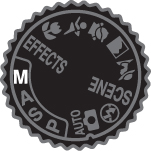Iso Settings Nikon D5200 for Wildlife Photography
This chapter is from the book
M: Manual Mode

Once upon a time, long before digital cameras and plan modes, there was manual mode. In those days information technology wasn't called "manual mode" because in that location were no other modes. It was just photography. In fact, many photographers cut their teeth on completely manual cameras. Let's face information technology—if y'all want to learn the furnishings of discontinuity and shutter speed on your photography, at that place is no better style to larn than by setting these adjustments yourself. Withal, today, with the advancement of camera technology, many new photographers never give this mode a 2nd thought. That'south truly a shame, every bit not only is it an excellent way to learn your photography basics, but it'southward besides an essential tool to accept in your photographic handbag of tricks.
When your camera is ready to Manual (Thou) style, the camera meter will give you a reading of the scene yous are photographing. It's your job, though, to ready both the f-stop (aperture) and the shutter speed to achieve a correct exposure. If you need a faster shutter speed, you lot will have to make the reciprocal change to your f-stop. Using any other mode, such as Shutter Priority or Aperture Priority, would hateful that you lot just have to worry about i of these changes, just Manual mode means you accept to do it all yourself. This can exist a piffling challenging at first, but after a while you will have a consummate understanding of how each change affects your exposure, which will, in turn, improve the way that you use the other modes.
When to Use Transmission (Thousand) Way
- When learning how each exposure element interacts with the others (Figure four.10)

Figure 4.x. Since my main subject was in the light, I gear up the camera to Manual then I could underexpose and continue the sky darker and more blue without worrying about the areas that fell into shadow.
- When your environment is fooling your light meter and you need to maintain a certain exposure setting (Effigy 4.11)

Figure 4.11. Sand and snow are always a challenge for light meters. Using Manual mode allowed me to prevent the scene from being underexposed.
- When shooting silhouetted subjects, which requires overriding the camera's meter readings (Figure 4.12)

Effigy 4.12. I used the spot meter on the bright groundwork and adapted exposure manually to put the subject into silhouette.
Setting Up and Shooting in Transmission Mode
- Turn your photographic camera on and then plow the Way dial to align the M with the indicator line.
- Select your ISO past pressing the i push on the dorsum of the photographic camera.
- Printing up or down on the Multi-selector to highlight the ISO pick, then select OK.
- Press downward on the Multi-selector to select the desired ISO setting, then press OK to lock in the change.
- Point the photographic camera at your discipline and and then activate the photographic camera meter by depressing the shutter push button halfway.
- View the exposure information in the bottom area of the viewfinder or by looking at the display console on the rear of the camera.
- While the meter is activated, use your thumb to gyre the Command dial left and right to alter your shutter speed value until the exposure mark is lined upward with the zilch mark. The exposure information is displayed past a scale with marks that run from -ii to +2 stops. A proper exposure will line up with the arrow mark in the middle. As the indicator moves to the left, it is a sign that yous will exist underexposing (in that location is too little light on the sensor to provide acceptable exposure). Motion the indicator to the correct and y'all will be providing more exposure than the camera meter calls for. This is overexposure.
- To set your exposure using the aperture, depress the shutter release button until the meter is activated. Then, while belongings down the Exposure Compensation/Aperture button (located behind and to the right of the shutter release button), rotate the Command dial to change the discontinuity. Rotate right for a smaller aperture (large f-terminate number) and left for a larger aperture (small f-cease number).

0 Response to "Iso Settings Nikon D5200 for Wildlife Photography"
Post a Comment